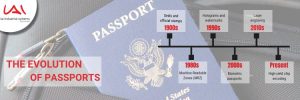Over the past century, passport security has evolved significantly to counter growing fraud activities. From basic identification features to advanced biometrics and tamper-resistant technologies, securing identities has remained central to passport design. As a strong participant in document printing and laser technology, IAI Industrial Systems has played a crucial role in this evolution, consistently improving secure personalisation and the quality of identity documents. This article explores the significant advancements in passport security over the last century.

The 1900s: The era of simplicity
In the early 20th century, modern passports began to develop. The first British passport from 1914 consisted of a single page, folded into eight, and held together with a cardboard cover. Valid for two years, it included a photograph, signature, and physical description of the holder. Security features at that time were limited to seals and official stamps, which could be relatively easy to counterfeit.
The 1980s: First steps in the passport security
The introduction of Machine-Readable Zones (MRZ) in the 1980s marked significant progress in passport security. A Machine-Readable Zone is a specialized area on many identity documents designed to be read by machines and enable accurate data extraction. This innovation optimized the process of verifying a document holder’s details and made the process of identity verification more secure, especially in international travel and border control.
The 1990s: Strengthening passport security
In 1998, the world’s first electronic passport was launched by Malaysia introducing biometric technology. A country where IAI has issued its passport in a later stage. Back in this time, embedded microprocessor chips provided more information about citizens. Holograms, watermarks, and complex background designs were added. Watermarks, incorporated during papermaking, can be checked by looking at the document against the light. Lastly, holograms created through a complex and expensive process, made the security of the passport even more difficult to breach.
The 2000s: Towards global standardization
In 2004, the first e-passports, storing digital photos and thumbprint biometric templates, were introduced for better identity verification. By 2006, the International Civil Aviation Organization (ICAO) established global standards for biometrics, leading to widespread adoption of e-passports, especially in the United States and the European Union. These passports featured embedded microchips, marking a significant enhancement in security.
The 2010s to Present: Progress at its peak
In recent times, the security of identity documents has been enhanced by introducing polycarbonate pages, which contributes to making the documents resistant to tampering. Laser engraving permanently imprints personal information, making any possible modifications nearly impossible without visible damage to the document. Modern passports also employ security printing techniques like micro text, high-yield chip encoding, and UV-reactive inks, adding layers of complexity that are difficult to replicate.
Passport Security Overview
The evolution of passport security over the past century has been developed by the need to respond to the advanced methods of forgeries and identity fraud. From simple stamps and holograms to biometrics and laser engraving, all technologies add layers of protection, making modern passports highly secure. As we look to the future, the integration of advanced biometrics, high-yield chip encoding, and laser engraving leads to a new era in which IAI Industrial Systems plays an important role. As the demand for stronger passport security continues to grow, we are proud to remain a trusted partner in this ongoing journey to protect identities and facilitate global trust.
